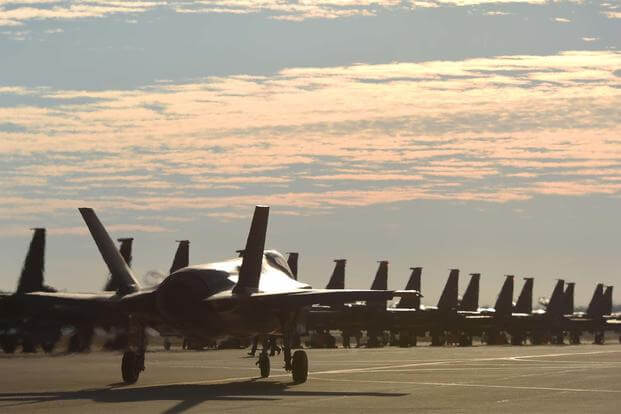News that two-thirds of the Navy's aging F/A-18 Hornets were stuck on the flightline lit up headlines last year. But the defense department's brand-new 5th-generation fighter program is also struggling to ensure that its shiny new aircraft are flyable, the three-star director of the program this week.
Of the 280 operational F-35s purchased to date by U.S. and international partners, only 51 percent are currently available for flight, Vice Adm. Mat Winter, director of the F-35 Joint Program Office, told reporters Wednesday at a round-table event.
Winter added that availability rates are lowest for aircraft purchased in early lots, which were beset with a number of hardware and software issues that later production lots addressed. Low-rate initial production lots 2 through 4 have availability rates between 40 and 50 percent, Winter said. The most recent LRIP lots, 9 and 10, which include aircraft that are still rolling off the production line, have the highest availability rates, 70 to 75 percent, he said.
"If you can afford to buy something, but you have to keep it in the parking lot because you can't afford to own and operate it, then it really doesn't do you much good," Winter said.
Part of the problem, Winter said, is the buggy autonomous logistics information system, or ALIS. The software, which among other things is designed to allow the aircraft to self-diagnose faulty or failing parts, sometimes creates false positives, telling maintainers a sound component had problems.
"They take it off and it's not bad but they don't know that, [so they] put it into the supply chain," Winter said. "[Then they] find out it's not bad and send it back."
All of that, of course, adds up to sleek 5th-generation aircraft sitting on the flightline or in hangars, unavailable to their units.
The good news, Winter said, is that the next version of ALIS, 3.0, eliminates many of these false positives. Moreover, he said, officials are working to make earlier generations of the aircraft more reliable in general while beefing up the maintenance pipeline at the same time.
"Sustaining that fleet requires the appropriate spare parts, trained maintenance personnel, and the systems and the tools to be able to do that maintenance," Winter said. "Likewise, we need a strong supply chain and supply base that can do repairables ... as well as generate new parts for spares and new parts for production."
The program is standing up organic government repair depots for the F-35 to fix the planes more efficiently and at lower cost, without having to rely on the industrial base to do the work. So far, Winter said, 68 different "subsystems" of the aircraft have been identified as items the government can repair organically.
"Things like tire and wheel, thermal management systems, avionics ... canopies," he said.
Throughout this fiscal year, Winter said, additional repair depots will be activated to do this work.
Meanwhile, he said, the program is working to increase the volume of spare parts production, so that U.S. an international aircraft have what they need in the supply chain to return to availability for flight as quickly as possible.
Also underway in Fiscal 2018 and 2019 is an effort to update the first batch of roughly 100 aircraft -- those in LRIPs 2 through 8 -- with hardware modifications for reliability and some software updates in line with the newest 3F block of software. These updates are expected to increase availability rates and reduce maintenance requirements.
"Once all those airframes are to that configuration, our ALIS ... eliminates the false positive, the spare parts are on the ramp where they're needed, and our repair capacity returning parts that need to be fixed is increased, our availability will be up and we'll be driving costs out," Winter said.
While the flyaway cost of the $100 million Joint Strike Fighter is steadily coming down with each production lot, Winter said it's crucial that these cost-savings and efficiency efforts take effect. In fact, he said, the ability of the military services to pay for the F-35 depends on it.
"The cost ratio we're experiencing today, if it's the same cost ratio into the future as our fleet grows from 280 aircraft to the 800-plus that we'll have by end of 2021, we will be unaffordable, in that the services' budgets will not be able to sustain that," Winter said. "So we are putting all of these measures that I talked about in place. We are reviewing and bringing that data back to the services so they can make good informed decisions about the path forward on sustainability and production capabilities."
-- Hope Hodge Seck can be reached at hope.seck@military.com. Follow her on Twitter at @HopeSeck.














